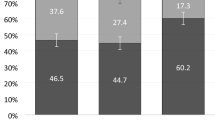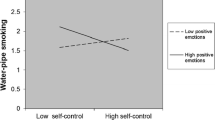Abstract
Motives may be an important influence for substance use among youth. The goal of this research was to study the relation of social, self-enhancement, boredom relief and affect regulation motives to smoking and drinking in a sample of Eastern European high school students and to examine variation in the effects of these motives by gender. Our sample involved 500 students (ages 14–20 years) from three high schools in a large city in Hungary. Multiple logistic regression analyses examined the relation between motives and substance user status. Social motives were significantly related to both smoking and drinking (except for boys’ smoking). Affect regulation motives were a significant predictor of smoking; in addition, boredom relief was a significant motive for smoking among boys. Mother’s educational level was inversely related to youth substance use, whereas father’s education was positively related to alcohol use among girls. School-based prevention programs should include cognitive education and social skills training to counter perceived benefits of substance use. Further research is needed to clarify the relation of alcohol use to parental education.
Similar content being viewed by others
References
Merline, A. C., O’Malley, P. M., Schulenberg, J. E., Bachman, J. G., & Johnston, L. D. (2004). Substance use among adults 35 years of age: Prevalence, adulthood predictors, and impact of adolescent substance use. American Journal of Public Health, 94, 96–102.
Weitzman, E. R., & Chen, Y. Y. (2005). The co-occurrence of smoking and drinking among young adults in college: National survey results from the United States. Drug and Alcohol Dependence, 80, 377–386.
Pitel, L., Geckova, A. M., Van Dijk, J. P., & Reijneveld, S. A. (2011). Degree of urbanization and gender differences in substance use among Slovak adolescents. International Journal of Public Health, 56, 645–651.
Piko, B. F., Wills, T. A., & Walker, C. (2007). Motives for smoking and drinking: Country and gender differences in samples of Hungarian and US high school students. Addictive Behaviors, 32, 2087–2098.
Lipperman-Kreda, S., Grube, J. W., & Paschall, M. J. (2010). Community norms, enforcement of minimum legal drinking age laws, personal beliefs and underage drinking: An exploratory model. Journal of Community Health, 35, 249–257.
Simons, J., Correia, C. J., & Carey, K. B. (2000). A comparison of motives for marijuana and alcohol use among experienced users. Addictive Behaviors, 25, 153–160.
Wills, T. A., Sandy, J. M., & Shinar, O. (1999). Cloninger’s constructs related to substance use level and problems in late adolescence: A mediational model based on self-control and coping motives. Experimental and Clinical Psychopharmacology, 7, 122–314.
Marschall-Lévesque, S., Castellanos-Ryan, N., Vitaro, F., & Séguin, J. R. (2014). Moderators of the association between peer and target adolescent substance use. Addictive Behaviors, 39, 48–70.
Ungar, M. T. (2000). The myth of peer pressure. Adolescence, 35, 167–180.
Kuntsche, E., Knibbe, R., Gmel, G., & Engels, R. (2005). Why do young people drink? A review of drinking motives. Clinical Psychology Review, 25, 841–861.
Kuntsche, E., Gabhainn, S. N., Roberts, C., et al. (2014). Drinking motives and links to alcohol use in 13 European countries. Journal of Studies on Alcohol and Drugs, 75, 428–437.
Lammers, J., Kuntsche, E., Engels, R. C., Wiers, R. W., & Kleinjan, M. (2013). Mediational relations of substance use risk profiles, alcohol-related outcomes, and drinking motives among young adolescents in the Netherlands. Drug and Alcohol Dependence, 133, 571–579.
Bradizza, C. M., Reifman, A., & Barnes, G. M. (1999). Social and coping reasons for drinking: Predicting alcohol misuse in adolescents. Journal of Studies on Alcohol, 60, 491–499.
Graziano, F., Bina, M., Giannotta, F., & Ciairano, S. (2012). Drinking motives and alcoholic beverage preferences among Italian adolescents. Journal of Adolescence, 35(4), 823–831.
Németh, Z., Kuntsche, E., Urbán, R., Farkas, J., & Demetrovics, Z. (2011). Why do festival goers drink? Assessment of drinking motives using the DMQ-R SF in a recreational setting. Drug and Alcohol Review, 30(1), 40–46.
Li, C., Unger, J. B., Schuster, D., Rohrbach, L. A., Howard-Pitney, B., & Norman, G. (2003). Youths’ exposure to environmental tobacco smoke (ETS). Associations with health beliefs and social pressure. Addictive Behaviors, 28, 39–53.
Guillon, M.-S., Crocq, M.-A., & Bailey, P. E. (2007). Nicotine dependence and self-esteem in adolescents with mental disorders. Addictive Behaviors, 32(4), 758–764.
O’Dell, L. E., & Torres, O. V. (2014). A mechanistic hypothesis of the factors that enhance vulnerability to nicotine use in females. Neuropharmacology, 76(B), 566–580.
McEwan, A., West, R., & McRobbie, H. (2008). Motives for smoking and their correlates in clients attending stop smoking treatment services. Nicotine and Tobacco Research, 10(5), 843–850.
Hanson, M., & Chen, E. (2007). Socioeconomic status and health behaviors in adolescence: A review of the literature. Journal of Behavioral Medicine, 30, 263–285.
Hiscock, R., Bauld, L., Amos, A., Fidler, J. A., & Munaf, M. (2012). Socioeconomic status and smoking: A review. Annals of the New York Academy of Sciences, 1248, 107–123.
Melotti, R., Heron, J., Hickman, M., Macleod, J., Araya, R., & Lewis, G. (2011). Adolescent alcohol and tobacco use and early socioeconomic position: The ALSPAC Birth Cohort. Pediatrics, 127, e948–955. http://pediatrics.aappublications.org/content/127/4/e948.long (Accessed 22 Nov 2014)
Humensky, J. L. (2010). Are adolescents with high socioeconomic status more likely to engage in alcohol and illicit drug use in early adulthood? Substance Abuse Treatment, Prevention, and Policy, 5, 19. http://www.substanceabusepolicy.com/content/5/1/19 (Accessed 19 Nov 2014)
Piko, B. F., & Fitzpatrick, K. M. (2007). Socioeconomic status, psychosocial health and health behaviors among Hungarian adolescents. European Journal of Public Health, 17, 353–360.
Musick, K., Seltzer, J. A., & Schwartz, C. R. (2008). Neighborhood norms and substance use among teens. Social Science Research, 37, 138–155.
Casswell, S., Pledger, M., & Hooper, R. (2003). Socioeconomic status and drinking patterns in young adults. Addiction, 98(5), 601–610.
Patrick, M. E., Wightman, P., Schoeni, R. F., & Schulenberg, J. E. (2012). Socioeconomic status and substance use among young adults: A comparison across constructs and drugs. Journal of Studies on Alcohol and Drugs, 73(5), 772–782.
Örkény, A., & Székelyi, M. (2000). Views on social inequality and the role of the state: Posttransformation trends in Eastern and Central Europe. Social Justice Research, 13, 199–218.
Kopp, M., Skrabski, A., Szekely, A., Stauder, A., & Williams, R. (2007). Chronic stress and social changes: Socioeconomic determination of chronic stress. Annals of the New York Academy of Sciences, 1113, 325–338.
Orosa, F. J. E. (2013). Psychosocial well-being in the Central and Eastern European transition: An overview and systematic bibliographic review. International Journal of Psychology, 48(4), 481–491.
Currie, C., Zanotti, C., Morgan, A., et al. (2012). Health Behaviour in School-Aged Children (HBSC) Study: International Report from the 2009/2010 Survey. Health Policy for Children and Adolescents, No. 6. Copenhagen, WHO Regional Office for Europe. http://www.hbsc.org/publications/international/ (Accessed 08 Nov 2014)
Cross, C. P., Copping, L. T., & Campbell, A. (2011). Sex differences in impulsivity: A meta-analysis. Psychological Bulletin, 137(1), 97–130.
Zhao, S. (2009). Parental education and children’s online health information seeking: Beyond the digital divide debate. Social Science and Medicine, 69, 1051–1055.
Reti, I. M., Samuels, J. F., Eaton, W. W., Bienvenu, J, III., Costa, P. T, Jr, & Nestadt, G. (2002). Influences of parenting on normal personality traits. Psychiatry Research, 111, 55–64.
Author information
Authors and Affiliations
Corresponding author
Rights and permissions
About this article
Cite this article
Piko, B.F., Varga, S. & Wills, T.A. A Study of Motives for Tobacco and Alcohol Use Among High School Students in Hungary. J Community Health 40, 744–749 (2015). https://doi.org/10.1007/s10900-015-9993-4
Published:
Issue Date:
DOI: https://doi.org/10.1007/s10900-015-9993-4




